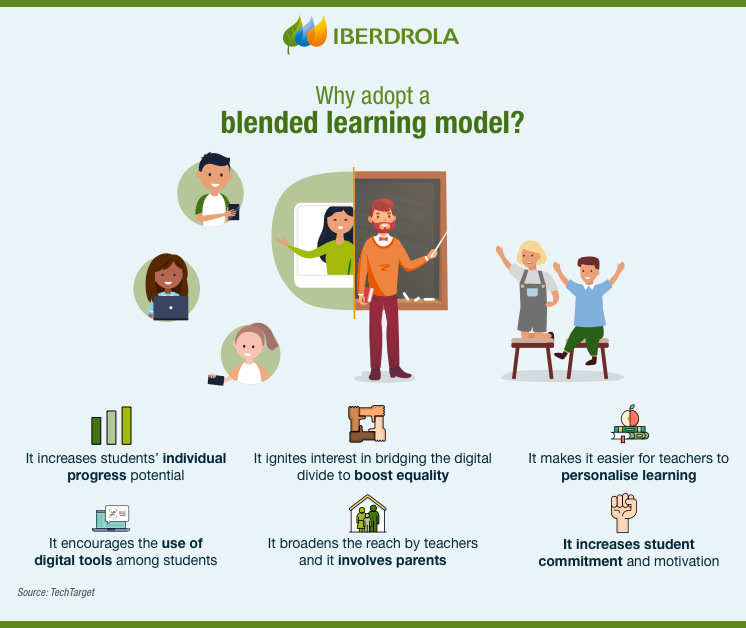Blended learning
How does blended learning work?
Digitisation has revolutionised education, enabling students to learn from anywhere. During the COVID-19 pandemic this has become fundamental and has reopened the debate on the educational model, making teachers and students ask themselves the following question: Has the time come to opt for a blended learning model?

The impact of digitalisation on education was already a reality before the COVID-19 pandemic with the rise of online education but it was made mainstream because of the lockdown, except in those cases where the digital divide makes it impossible, forcing students to access education from home. After the first wave, the teaching world faced the challenge of the new school year and this is where blended learning emerged as a firm commitment in the present and looking to the future.
What is blended learning
Blended learning, also known as b-learning, is a type of learning that combines remote and face-to-face teaching with one objective: to bring together the best of both worlds to achieve more efficient learning. Although not new, this model of disruptive education emerged in the late 1990s from the Clayton Christensen Institute for Disruptive Education and the rapid development of Information and Communication Technologies (ICT) has caused this and other e-learning models to take off.
"Online learning is not the big issue of the future, it is the big issue of the present"
Donna J. Abernathy, writer and e-learning researcher
There is no single way of applying blended learning, that is to say, the way in which this method of teaching is taught depends on the interests of each centre since some give more prominence to face-to-face classes, while in others the digital aspect takes precedence. One benchmark is High Tech High, a network of American schools that has been committed to this model for years. Their students use online programs to supplement maths or language classes and, judging by the fact that 98 % of their students go on to university, it could be called a success.
Modalities of blended learning
The Clayton Christensen Institute for Disruptive Innovation identifies four key models:
 Rotation
Rotation
Students rotate between different learning modes, one of which is virtual, according to a fixed schedule or at the teacher's discretion. This model offers various options from stations, laboratory and individual, but the most famous is the flipped classroom, in which students learn outside the classroom through online educational resources and perform practical tasks in the classroom under the guidance of the teacher.
 Flexible
Flexible
Teachers instruct and support their students in class on a flexible, on-demand schedule of tutorials, for example, while students progress at their own pace through online platforms.
 A la carte
A la carte
Students choose which subjects to be taught online. This will depend on the centre's own offering while the rest of the subjects will be taught in the classroom in person.
 Online enhanced
Online enhanced
Students have a few sessions in the classroom, but then have the freedom to complete the course online. Although they do not meet face-to-face with their teachers every day of the week, they do require a certain number of hours of face-to-face learning.
Advantages and disadvantages of blended learning
Below we list some of the main advantages of blended learning: it improves student motivation and performance, promotes participation, self-learning and teamwork, opens new forms of interrelation between teachers and students, allows greater flexibility, boosts digital intelligence and the acquisition of digital skills, etc.
But this learning model is not without its disadvantages. According to specialists, the main one is that initially it can be complicated given the demand for individual work and the essential acquisition of technological skills that it entails, and it can cause a lengthening of the learning curve.

SEE INFOGRAPHIC: Why adopt a blended learning model? [PDF] External link, opens in new window.
How to develop a blended learning model
The main steps to successfully implement a blended learning model are as follows:
1. Have a plan. Implementing a blended learning model involves a strategic change that requires, in turn, a plan from the centre's management.
2. Take it step by step. Setting clear objectives and systematically implementing the plan allows you to learn quickly from any mistakes. In addition, small successes bring knowledge and motivation.
3. Involve the staff of the centre. It is vital to consult with teachers, but also students and parents, to better understand what they need and want at all times.
4. Have suitable resources. The materials for online teaching are different from those for face-to-face teaching. Attractive interactive content enhances the learning experience.
5. Adapt the technology to the needs. It is necessary to consider how technology can help teachers and students achieve the best possible learning.
6. Evaluate the results. Collecting the data and analysing the information constantly is the best way to know whether the objectives have been achieved or not.




